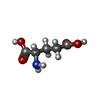[English] 日本語
 Yorodumi
Yorodumi- PDB-2f36: Crystal Structure of the GluR5 Ligand Binding Core Dimer with Glu... -
+ Open data
Open data
- Basic information
Basic information
| Entry | Database: PDB / ID: 2f36 | ||||||
|---|---|---|---|---|---|---|---|
| Title | Crystal Structure of the GluR5 Ligand Binding Core Dimer with Glutamate At 2.1 Angstroms Resolution | ||||||
 Components Components | GLUTAMATE RECEPTOR, IONOTROPIC KAINATE 1 | ||||||
 Keywords Keywords | MEMBRANE PROTEIN | ||||||
| Function / homology |  Function and homology information Function and homology informationnegative regulation of synaptic transmission, GABAergic / gamma-aminobutyric acid secretion / L-glutamate transmembrane transporter activity / positive regulation of gamma-aminobutyric acid secretion / Activation of Na-permeable kainate receptors / kainate selective glutamate receptor complex / Activation of Ca-permeable Kainate Receptor / regulation of short-term neuronal synaptic plasticity / negative regulation of synaptic transmission, glutamatergic / glutamate binding ...negative regulation of synaptic transmission, GABAergic / gamma-aminobutyric acid secretion / L-glutamate transmembrane transporter activity / positive regulation of gamma-aminobutyric acid secretion / Activation of Na-permeable kainate receptors / kainate selective glutamate receptor complex / Activation of Ca-permeable Kainate Receptor / regulation of short-term neuronal synaptic plasticity / negative regulation of synaptic transmission, glutamatergic / glutamate binding / inhibitory postsynaptic potential / synaptic transmission, GABAergic / adult behavior / behavioral response to pain / kainate selective glutamate receptor activity / modulation of excitatory postsynaptic potential / extracellularly glutamate-gated ion channel activity / ionotropic glutamate receptor complex / membrane depolarization / glutamate-gated receptor activity / glutamate-gated calcium ion channel activity / presynaptic modulation of chemical synaptic transmission / ligand-gated monoatomic ion channel activity involved in regulation of presynaptic membrane potential / ionotropic glutamate receptor signaling pathway / SNARE binding / positive regulation of synaptic transmission, GABAergic / regulation of membrane potential / transmitter-gated monoatomic ion channel activity involved in regulation of postsynaptic membrane potential / synaptic transmission, glutamatergic / excitatory postsynaptic potential / establishment of localization in cell / postsynaptic density membrane / regulation of synaptic plasticity / modulation of chemical synaptic transmission / terminal bouton / nervous system development / presynaptic membrane / scaffold protein binding / chemical synaptic transmission / postsynaptic membrane / receptor complex / postsynaptic density / neuronal cell body / synapse / dendrite / glutamatergic synapse / identical protein binding / membrane / plasma membrane Similarity search - Function | ||||||
| Biological species |  | ||||||
| Method |  X-RAY DIFFRACTION / X-RAY DIFFRACTION /  SYNCHROTRON / SYNCHROTRON /  MOLECULAR REPLACEMENT / Resolution: 2.11 Å MOLECULAR REPLACEMENT / Resolution: 2.11 Å | ||||||
 Authors Authors | Mayer, M.L. | ||||||
 Citation Citation |  Journal: J.Neurosci. / Year: 2006 Journal: J.Neurosci. / Year: 2006Title: Crystal structures of the kainate receptor GluR5 ligand binding core dimer with novel GluR5-selective antagonists. Authors: Mayer, M.L. / Ghosal, A. / Dolman, N.P. / Jane, D.E. #1:  Journal: Neuron / Year: 2005 Journal: Neuron / Year: 2005Title: Crystal Structures of the GluR5 and GluR6 Ligand Binding Cores: Molecular Mechanisms Underlying Kainate Receptor Selectivity Authors: Mayer, M.L. | ||||||
| History |
| ||||||
| Remark 300 | Author states: Dimers formed by chains A and B, and by chains C and D, are believed to occur in the ...Author states: Dimers formed by chains A and B, and by chains C and D, are believed to occur in the intact membrane protein. |
- Structure visualization
Structure visualization
| Structure viewer | Molecule:  Molmil Molmil Jmol/JSmol Jmol/JSmol |
|---|
- Downloads & links
Downloads & links
- Download
Download
| PDBx/mmCIF format |  2f36.cif.gz 2f36.cif.gz | 218.7 KB | Display |  PDBx/mmCIF format PDBx/mmCIF format |
|---|---|---|---|---|
| PDB format |  pdb2f36.ent.gz pdb2f36.ent.gz | 175.8 KB | Display |  PDB format PDB format |
| PDBx/mmJSON format |  2f36.json.gz 2f36.json.gz | Tree view |  PDBx/mmJSON format PDBx/mmJSON format | |
| Others |  Other downloads Other downloads |
-Validation report
| Summary document |  2f36_validation.pdf.gz 2f36_validation.pdf.gz | 489.8 KB | Display |  wwPDB validaton report wwPDB validaton report |
|---|---|---|---|---|
| Full document |  2f36_full_validation.pdf.gz 2f36_full_validation.pdf.gz | 511.8 KB | Display | |
| Data in XML |  2f36_validation.xml.gz 2f36_validation.xml.gz | 44.4 KB | Display | |
| Data in CIF |  2f36_validation.cif.gz 2f36_validation.cif.gz | 62.7 KB | Display | |
| Arichive directory |  https://data.pdbj.org/pub/pdb/validation_reports/f3/2f36 https://data.pdbj.org/pub/pdb/validation_reports/f3/2f36 ftp://data.pdbj.org/pub/pdb/validation_reports/f3/2f36 ftp://data.pdbj.org/pub/pdb/validation_reports/f3/2f36 | HTTPS FTP |
-Related structure data
| Related structure data |  2f34C  2f35C  1txfS S: Starting model for refinement C: citing same article ( |
|---|---|
| Similar structure data |
- Links
Links
- Assembly
Assembly
| Deposited unit | 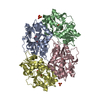
| ||||||||
|---|---|---|---|---|---|---|---|---|---|
| 1 |
| ||||||||
| Unit cell |
|
- Components
Components
| #1: Protein | Mass: 29211.531 Da / Num. of mol.: 4 Fragment: GluR5 ligand binding core (sequence database 446-559 and 682-821) Mutation: E791S Source method: isolated from a genetically manipulated source Source: (gene. exp.)   #2: Chemical | ChemComp-SO4 / #3: Chemical | ChemComp-GLU / #4: Water | ChemComp-HOH / | Has protein modification | Y | |
|---|
-Experimental details
-Experiment
| Experiment | Method:  X-RAY DIFFRACTION / Number of used crystals: 1 X-RAY DIFFRACTION / Number of used crystals: 1 |
|---|
- Sample preparation
Sample preparation
| Crystal | Density Matthews: 2.2 Å3/Da / Density % sol: 44.5 % |
|---|---|
| Crystal grow | Temperature: 293 K / Method: vapor diffusion, hanging drop / pH: 7.1 Details: 1.75 M Ammonium Sulfate 100 mM HEPES 10 mM glutamic acid, pH 7.1, VAPOR DIFFUSION, HANGING DROP, temperature 293K |
-Data collection
| Diffraction | Mean temperature: 100 K |
|---|---|
| Diffraction source | Source:  SYNCHROTRON / Site: SYNCHROTRON / Site:  APS APS  / Beamline: 22-ID / Wavelength: 0.99997 Å / Beamline: 22-ID / Wavelength: 0.99997 Å |
| Detector | Type: MARRESEARCH / Detector: CCD / Date: Oct 12, 2004 |
| Radiation | Monochromator: Double Crystal Si-220 / Protocol: SINGLE WAVELENGTH / Monochromatic (M) / Laue (L): M / Scattering type: x-ray |
| Radiation wavelength | Wavelength: 0.99997 Å / Relative weight: 1 |
| Reflection | Resolution: 2.1→30 Å / Num. all: 53310 / Num. obs: 53310 / % possible obs: 99.8 % / Observed criterion σ(F): 2.11 / Observed criterion σ(I): 1 / Redundancy: 3.4 % / Rmerge(I) obs: 0.084 / Net I/σ(I): 12.3 |
| Reflection shell | Resolution: 2.1→2.18 Å / Rmerge(I) obs: 0.344 / Mean I/σ(I) obs: 3.62 / % possible all: 100 |
- Processing
Processing
| Software |
| ||||||||||||||||||||||||||||||||||||||||||||||||||||||||||||||||||||||||||||||||||||||||||||||||||||||||||||||||||||||||||||||||||||||||||||||||||||||||||||||||||||||||||
|---|---|---|---|---|---|---|---|---|---|---|---|---|---|---|---|---|---|---|---|---|---|---|---|---|---|---|---|---|---|---|---|---|---|---|---|---|---|---|---|---|---|---|---|---|---|---|---|---|---|---|---|---|---|---|---|---|---|---|---|---|---|---|---|---|---|---|---|---|---|---|---|---|---|---|---|---|---|---|---|---|---|---|---|---|---|---|---|---|---|---|---|---|---|---|---|---|---|---|---|---|---|---|---|---|---|---|---|---|---|---|---|---|---|---|---|---|---|---|---|---|---|---|---|---|---|---|---|---|---|---|---|---|---|---|---|---|---|---|---|---|---|---|---|---|---|---|---|---|---|---|---|---|---|---|---|---|---|---|---|---|---|---|---|---|---|---|---|---|---|---|---|
| Refinement | Method to determine structure:  MOLECULAR REPLACEMENT MOLECULAR REPLACEMENTStarting model: PDB 1TXf Resolution: 2.11→29.87 Å / Cor.coef. Fo:Fc: 0.952 / Cor.coef. Fo:Fc free: 0.921 / SU B: 10.362 / SU ML: 0.143 / TLS residual ADP flag: LIKELY RESIDUAL / Cross valid method: THROUGHOUT / σ(F): 0 / ESU R: 0.268 / ESU R Free: 0.21 / Stereochemistry target values: MAXIMUM LIKELIHOOD / Details: HYDROGENS HAVE BEEN ADDED IN THE RIDING POSITIONS
| ||||||||||||||||||||||||||||||||||||||||||||||||||||||||||||||||||||||||||||||||||||||||||||||||||||||||||||||||||||||||||||||||||||||||||||||||||||||||||||||||||||||||||
| Solvent computation | Ion probe radii: 0.8 Å / Shrinkage radii: 0.8 Å / VDW probe radii: 1.2 Å / Solvent model: MASK | ||||||||||||||||||||||||||||||||||||||||||||||||||||||||||||||||||||||||||||||||||||||||||||||||||||||||||||||||||||||||||||||||||||||||||||||||||||||||||||||||||||||||||
| Displacement parameters | Biso mean: 28.726 Å2
| ||||||||||||||||||||||||||||||||||||||||||||||||||||||||||||||||||||||||||||||||||||||||||||||||||||||||||||||||||||||||||||||||||||||||||||||||||||||||||||||||||||||||||
| Refinement step | Cycle: LAST / Resolution: 2.11→29.87 Å
| ||||||||||||||||||||||||||||||||||||||||||||||||||||||||||||||||||||||||||||||||||||||||||||||||||||||||||||||||||||||||||||||||||||||||||||||||||||||||||||||||||||||||||
| Refine LS restraints |
| ||||||||||||||||||||||||||||||||||||||||||||||||||||||||||||||||||||||||||||||||||||||||||||||||||||||||||||||||||||||||||||||||||||||||||||||||||||||||||||||||||||||||||
| LS refinement shell | Resolution: 2.114→2.169 Å / Total num. of bins used: 20
| ||||||||||||||||||||||||||||||||||||||||||||||||||||||||||||||||||||||||||||||||||||||||||||||||||||||||||||||||||||||||||||||||||||||||||||||||||||||||||||||||||||||||||
| Refinement TLS params. | Method: refined / Refine-ID: X-RAY DIFFRACTION
| ||||||||||||||||||||||||||||||||||||||||||||||||||||||||||||||||||||||||||||||||||||||||||||||||||||||||||||||||||||||||||||||||||||||||||||||||||||||||||||||||||||||||||
| Refinement TLS group |
|
 Movie
Movie Controller
Controller


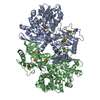
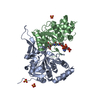

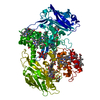
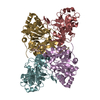

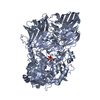



 PDBj
PDBj




